Since the state of the culture layers and the condition of the earth layer at the Shillacto site have aheady been described in detail, in the excavation course of this report, the overall stratigraphic relations for the entire excavation area will be considered here on the basis of the findings of each section.
The horizon within the excavation area, which extends on the northern side of the Shillacoto site for about 20 m. in length, 20 m. in width and 6 m. in average depth, may be classified into four main strata corresponding to four periods of culture. And these strata could be sub-divided into 18 layers on the basis of the floor face, ash layer as well as the tone and nature of those pebbles, and earth containing various structures.
1st Layer: This is a surface soil of about 20 cm. in depth; However, there were many small pebbles exposed on the surface on the northern side.
2nd Layer: This is a pebble layer with a small quantity of carth. The pebbles lay especially thick on the northern side, to 2 m.-1.5 m., but became thin on the southern side, to 60 cm.-30 m. There were no particular relics in any section, and no pebbles layer existing in those places which seemed to have already been excavated. For instance, instead of the pebbles, a layer of soft dark-brown earth was found all over the area of B-2 and B-3.
3rd Layer: This is a yellow-brown earth layer, which is a continuation of the upper layer of pebbles. Dry rough grains of yellow-brown earth increase as the quantity of pebbles decreases. This earth layer, too, becomes thick on the northern side and thin on the southern side. There was no such earth layer existing in E, F-3 and F-4.
4th Layer: This is a red-brown earth layer, which contains, instead of an upper layer of pebbles, rubble, fallen wall stones, carbon and charcoal. The soil is of a clay type. This earth layer covers the Higueras Period structures in the upper layer. In E-2-F-5, this layer was found directly beneath the layer of rock fragments. The number of pieces of earthenware became increasingly large in this layer; although the majority were of the Higueras Period, some of the Kotosh and Wairajirca Periods were also found in the upper layer.
5th Layer: This layer of red-brown earth of about 10 cm. thick is either a floor or the earth composing a floor. In the upper part there is an ash layer containing charcoal and burned clods. The floor face corresponds to the upper layer of Higueras Period structures.
6th Layer: This is a layer of grey-brown or light brown earth. This relatively hard layer contains some rock fragments. In E and F, there are tombs dug into this layer. The archaeological remains unearthed from this layer are of the Higueras Period.
7th Layer: This red-brown earth layer of a clay type, about 8-10 cm. thick is either a floor or an earth that composed a floor. The floor earth contains small stones. This floor corresponds to the floor of the Higueras Period structures. Over the area of A-3, A-4, B-3, B-4, C-3 and C-4, this type of floor was damaged beyond recognition.
8th Layer: This is a brown earth layer containing small boulders. Carbon and charcoal were scattered in this layer. Over the area of A-3-A-5, B-3-B5 and C-3-C-5, the 7th layer floor mixed with the 8th layer, making it difficult to recognize the two separately. Over the area of E, F, and G zones, the tombs of the Higeras Period were dug into this layer, and pieces of earthenware of both the Higueras and Kotosh Periods were unearthed from this layer.
9th Layer: This is a dark brown earth layer containing fallen wall stones and pebbles. In some parts of the layer were found a charcoal layer and thick pile of ash. This layer also contained some tombs of Higueras Period, but held pieces of earthenware and materials of the Kotosh Period only.
10th Layer: This is either a floor or the earth layer over a floor, corresponding to the floor face of a Kotosh Period constructions. There existed two floor faces belonging to both the upper and lower layers. The floor of S-R1, S-R2, and S-R3 is the upper layer floor. This floor cemented with clay is firm and sturdy, measuring 15-20 cm. in thickness. A thick ash layer spread over the floor and contained a large quantity of pieces of earthenware of the Kotosh Period. The lower layer floor corresponds to the floor of S-R11, and S-R12. This red-brown earth floor is about 15 cm. thick, and considerably damaged by wall stones which had fallen from above. Each of those two floor faces was located at different spots and the two were not found overlapping at one spot. However, they were judged to be of the same period ; although the height of each floor was not the same, it was considered that there had been two groups of constructions and the two had been connected by means of a stairway, an inclined passage, or in some other way.
11th Layer: This is a dark brown earth layer containing a large quantity of boulders. Over the area from E-2 to E-4, this layer contained two ash layers, upper and lower, from which a mixture of the Kotosh and Wairajirca Period ceramic ware was discovered. The ash layer was partly recognized also in B and C zones. Although it contains a large quantity of rock fragments, the soil is compact and the layer itself is quite firm. There was no such layer existing in C-2 ; the floor of S-R3 was constructed directly on a platform-like construction (tomb) of the Wairajirca Period.
12th Layer: This is a light brown or grey-brown earth layer with small pieces of earth content, but with a large quantity of rubble or breccias. Ceramic sherds of the Wairajirca Period increased overwhelmingly in this layer. Mixed with breccias, a large quantity of stone implements were unearthed from this layer. In any of the excavation sections, this layer was discovered under those structures of the K-otosh Period. Noteworthy was the fact that this layer had contained a large quantity of artifacts of the Wairajirca Period. In A-1-A-4, B as well as C-1, C-3 and 0-4, the upper floor of a temple was exposed directly beneath the breccia layer.
13th Layer: The rubble layer mentioned above changed into a dark brown earth layer containining boulders and the quantity of rock fragments gradually decreased as we dug further down. The relics unearthed in those layers were only of the Wairajirca Period. However, in SHE, SHF, SHG, as well as SHB and SHC-4, the 12th layer of breccia continued intermittently, while the soil remained grey-brown. In other words, we could not recognize a transition into the 13th layer.
14th Layer: This black-brown clay layer containing some gravel is cither a floor or the layer over a floor. The layer over a floor contained the relics of the Wairajirca Period. This black-brown floor was evident inside the temple on the western side, while the breccia layer was too thick for us to recognize the black-brown floor face on the eastern side of the temple, i.e., SHD, E. F, and G.
15th Layer: This red-brown clay floor of 10 cm.-15 cm. in thickness was stuck directly to a temple floor, and the foundation stone of the tomb structures of the Wairajirca Period was installed on this floor. There were some ceramic fragments of the Wairajirca Period contained also in this red clay floor. The red clay spread only within the temple building on the western side.
16th Layer: This chocolate clay layer is the original lower floor of the temple discovered during our latest survey. This is a firm floor of about 50 cm. in thickness, which contained rock fragments but, almost no relics.
17th Layer: This yellow-brown layer is a flooring, which is considered to correspond to the floor of another temple in the lower layer. During our latest survey, we discovered this floor, when we dug down only from inside the temple on the western side. There were no relics in it.
18th Layer: This layer was discovered when we dug deep only at one spot of the northern pan of the initial Trench B. This black-brown earth layer contains rubble, ashlars and fragments of micaschist. Beneath this layer, we found a temple floor in a still lower layer; a hearth was also discovered on that floor face. Therefore, it was established that temples of at least three periods liad existed at Shillacoto, overlapping one on top of the other.
CONSTRUCTIONS
At Shillacoto Site, the culture of four different periods overlapped from the top layer to lower layers; Shillacoto-Higueras, Shillacoto-Kotosh, Shillacoto-Wairajirca and Shillacoto-Mito, in that order. Although a small number of Chavin style ceramic wares were unearlhed, this fact was not enough to prove that the culture existed there, and our latest survey failed to discover any structures related to such a culture. Neither could we discover any pieces of earthenwares,structures, or other cultural remains corresponding to Sajarapatac and San Bias as in the case of the Kotosh Site.





Fig. 10 |
Constructions of Higueras Period
The pieces of earthenware and other relics of the Higueras Period were present throughout the excavation sections, but those constructions to be recognized as architecture were unearthed mainly in E Section; the Higueras Culture also existed over the upper and lower layers at Shillacoto.
S-R8: A construction belonging to the upper layer Higueras Period Culture. It was termed S-R8 on the basis of the existence of S-W31 and S-W32 and a floor face that corresponds to the two walls. However, as previously mentioned, S-W31 and S-W32 are independent walls with no recognizable relationship between the two. Neither the plan nor the dimension of the room could be ascertained. The extent of the damage to S-W31 was considerable; the remaining wall measured about 5.5 m. in length, 60 cm. in width and 60 cm. in height. The cross section of the wall exposed at the eastern end showed that a flat stone cut to approximately 30 cm.-40 cm, × 10 cm. was placed at each end with smaller ashlars placed in between. However, since a base portion, about 30 cm. high, was the only remnant of S-W31, we could not figure out what it had been like as a whole. At the western end, pebbles filled the upper part of this wall. S-W32 is a straight wall stretching from E-6 to D-5 ; what remained measured approximately 5.5 m. × 80 cm. × 60 cm. S-W32 is a quite sturdily constructed wall; there were relatively large rectangular ashlars as well as natural stones making up the wall with the face at both sides (PL. 3-c). The floor face spreading over the base of S-W31 connected with the floor face of the S-W32 foundation stone; consequently we judged them to be of the same period. Made up of about 10 cm. deep red-brown clay, this floor was relatively sturdy.
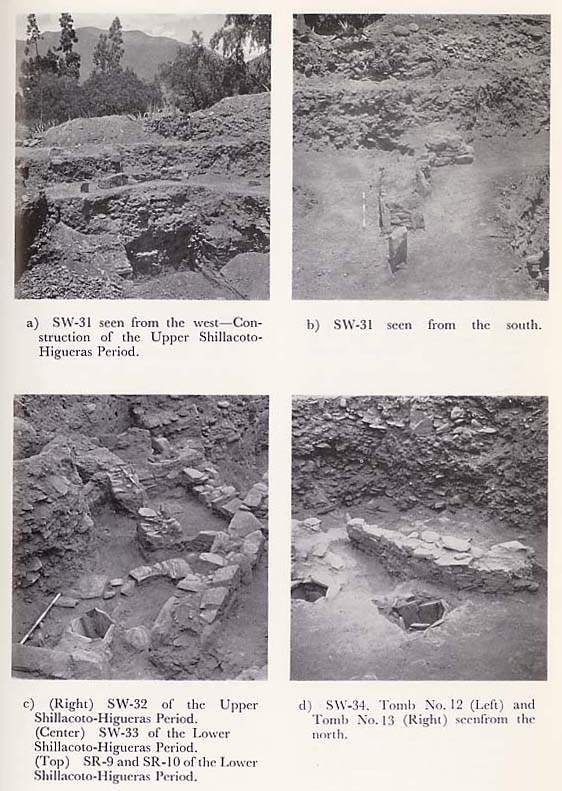
PLATE 3 |
S-R9 (PL. 3-c): A room excavated from under the S-R8 floor, considered to belong to the lower layer Higueras Period. Consisting of S-W35, S-W36, S-W37, S-W38 and S-W39, what remained of this room measured approximately 3.5m. × 2.5 m., and the wall remained in its original form for about 60 cm. in height. S-W35 and S-W36 are the walls forming the western entrance. The entrance is about 1 m. in width, and the average thickness of the walls is 60-70 cm. S-W38 was most sturdily constructed, The walls were generally built with a combination of ashlars and natural stones, but S-W37 was built with flat stones of finely cut face arranged horizontally, presenting a beautifully finished wall face. Noteworthy was the central part of S-W37; part of the wall was cut or shaved from the uppermost face to accommodate several thin slates of micaschist. Encircled by this wall of fine masonry was a tomb (Tomb No. 7). Also to the west of S-R10, we discovered a tomb-like hole, which was termed, Tomb No. 9. The floor was constructed approximately 40 cm. from the upper face and it was cemented with red-brown clay, mixed with pebbles.
S-R10 (PL. 3-c): A room belonging to the lower layer Higueras Period, situated to the north of S-R9 and adjoining it. This room consisted of S-W36, S-W37, S-W40 and S-W41, of which the first two are the walls common to S-R9.S-W41 was poorly preserved ; only about one step of the stone foundation hadremained intact. The eastern wall of S-R10 had been completely destroyed. The dimension of this room was presumed to be 3.5 m. × 2.5., approximately the same size of S-R9. The collapsed wall stones had dug into the floor, and the floor face itself had degenerated into a soft state, making it totally impossible for us to have a clear picture.
S-W33 and S-W34 (PL. 3-c and d): These walls were excavated from the lower layer beneath the floor in the south-western part of S-W32. Both S-W33. and S-W34 are the walls belonging to the lower layer Higueras Period. S-W33 is a curved wall running through the sections from D-4 to E-5. Although S-W33 was in contact with S-W34, the two were not joined or connected with each other. These were low 2 tier stone walls, and there were flat ashlars piled up on the upper face. The upper face of S-W34 is one stone step lower than that of S-W33. It is a wall of rectangular ashlars, having two faces, and the southern side isstepped and one step lower than the other side. S-W34 is also a curved wall extending from east to west; its width is about 40 cm.
Constructions of Kotosh Period
The Kotosh Period constructions may be roughly classified into two types on the basis of wall construction and plan. One is the type of rooms found mainly in the zones of B, C, and D. For the construction of walls, pebbles and natural. stones were mainly used; the stones were simply piled up while making the face even. The inner gaps between stones were filled with fine gravel and mud while the gaps on the wall face were filled with rough grey-brown earth pointing. The plan was either circular or somewhat curved like a drum. S-R1, S-R2, and S-R3 belong to this type (PL. 4-a, b and c). However, although circular in its plan, S-R4 constructed in a different way because it was meant to be a tomb.
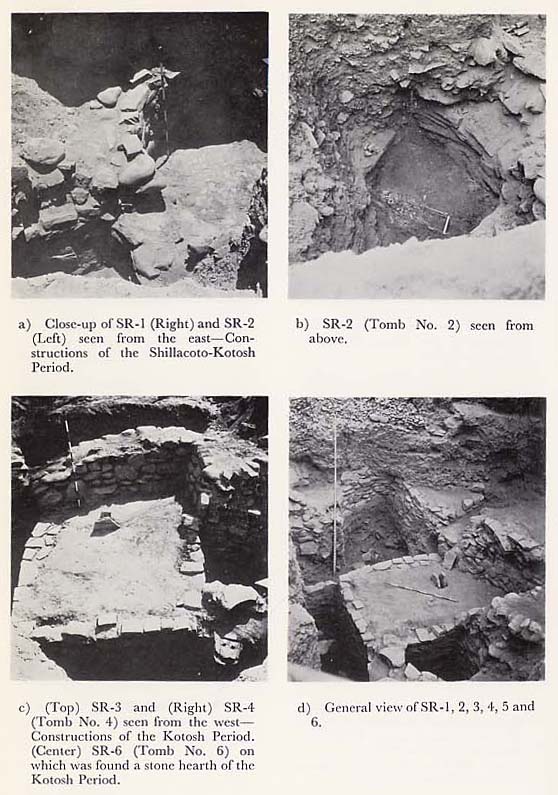
PLATE 4 |
The other type is those discovered in the two sections of SHE and SHF. Those walls were constructed mainly with rectangular or flat stones with neatly dressed face. At the corner where two walls joined, the two faces were dexterously engaged with each other at an acute angle. The walls are generally thick and sturdily built. The plan is generally rectagular. Good clay of relatively fine grains was used for pointing the walls, and only a small quantity of rock fragments and other fillings was used inside.
Since we have already made a detailed report on S-R1, S-R2, and S-R3 in Chapter I, only the second type of structures will be explained here.
S-R11 (PL. 7-a, b): A room consisting of S-W42, S-W43, S-W44, and S-W45. The western walls were completely destroyed. The dimension was presumed to be 5 m. × 5 m.; the wall thickness 90 cm.-1 m. Rectangular ashlars or flat stones of about 30 cm.-50 cm. were crossed at random and the face was made even as the stones were piled up. Red-brown clay of fine grains was used for pointing. S-W44 and S-W45 were more finely and sturdily constructed, with a width of 1.2 meters. Although the two are one single wall, S-W44 is about 25 cm. wide and this stepped wall is one step lower than the other. Although there was no trace of coating on the wall, we recognized a thin layer of yellow clay at several points on the red-brown floor, indicating the existence of an extra flooring over the floor. On the western side in the center of the room, there was a hearth about 20 cm. elevated from the floor and framed by flat stones cut neatly to a square. The southern end of S-W44 and S-W45 was presumed to have been destroyed when a tomb of the Higueras Period was constructed.

PLATE 7 |
S-R12 (PL. 7-c, d): A room surrounded by S-W46, S-W47 and S-W48. The construction technique is slightly inferior to that of' S-R11. The southern wall had been destroyed. This room was presumed to be 5.5 m. × 4 m. S-W47 on the north is a wall becoming slightly wider towards the central part. Natural. stones were used for part of the wall, and fine ashlars were used for the upper section of the wall. The floor constructed at the depth of about 60 cm. was considerably damaged. Close to the wall in the central part of the room, a tomb of the Higueras Period (Tomb No. 15) was constructed about 10cm. lower than the wall. This is a Higueras Period tomb dug from the upper layer. About 1.5 m. west of S-W48, we discovered another Higueras Period tomb (Tomb No. 16), from which a ceramic figurine was unearthed (PL. 19-d).

PLATE 19 |
Constructions of Wairajirca Period
S-R6 (PL. 8 and 9): this construction measuring about 3.7m. × 3.2m × 2m. was an independent altar or a small platform-like stone structure with a tomb inside. The construction was made of piled up fine dressed stones. The upper surface of the structure was firmly cemented with red-brown clay. The interior of the structure, or the tomb chamber, measured about 2.1 m. × 1.4m. × 1.2 m. Smaller dressed stones were used as material for the interior wall of the construction, the total wall surface being originally coated with red-brown clay of 2 cm. thick. The clay surface was further finished with thin, fine grained white plaster. Furthermore, a red paint material was coated around the part about 50 cm. from the bottom. Although a considerable amount of coated clay had fallen from the wall surface, the white plaster on the upper section of the east wall and the red paint on the base of the north wall remained in a comparatively good condition. The following are the observations relating to the condition of the interior of the tomb chamber made during the course of the excavations.

PLATE 8 |
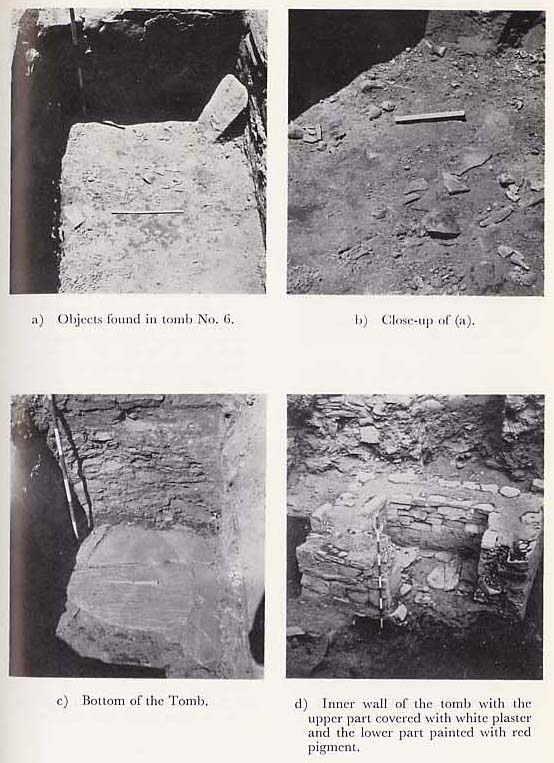
PLATE 9 |
First, the upper surface of the outer wall of the construction was cemented with red-brown clay containing a large quantity of small pebbles. At a position about 60 cm. from the upper part, we have the top portion of the interior wall; careful observations revealed that the upper section of the interior wall or the tomb chamber was not plugged, and it remained in a disorderly condition, showing signs of having been excavated previously. A considerable quantity of rock fragments of the upper section of the interior was unearthed. Several flat stones, measuring about 70 cm. × 80 cm. were discovered lying in disorder on top of one another, mingled with earth. When the scattered earth was removed, a remnant of a structure paved with several flat stones appeared near the floor level. By further removing the flat stones, a similar number of flat stones also appeared from underneath, together with what could be identified as human bones; and after these objects were removed, buried human bones finally appeared.
Skeletons of seven bodies were discovered-five near the east wall and two near the center. In other words, five skulls, the vertebrae, the pelvis, the femur, rib bones, finger bones and teeth were found scattered on the floor near the cast wall. The bones remained in a very poor condition due to the moisture of the clay. Furthermore, the two bodies found near the center were lying in a northsouth direction, one on top of the other. A skull, the humerus, and the femur were found near the south-wall, and a skull, the femur and rib bones were discovered near the north wall. All bones remained in a poorly preserved condition. Also, bone fragments of other parts of the bodies were found scattered all over, indicating clearly that the tomb chamber had been disturbed before.
The funeral objects, buried together with the dead, were: a small T-shape polished stone axe (PLs. 9-b, 34-3), a semi-circular jet mirror (PL. 42-2), and two large ceramic sherds with incised anthropomorphic design of apes (PLs. 9-b and 31-2). The earthenware pieces of hard and excellent quality with red-brown or purple-red colors, representing typical examples of the Wairajirca ceramic type, showed that the tomb belonged to the Wairajirca Period.
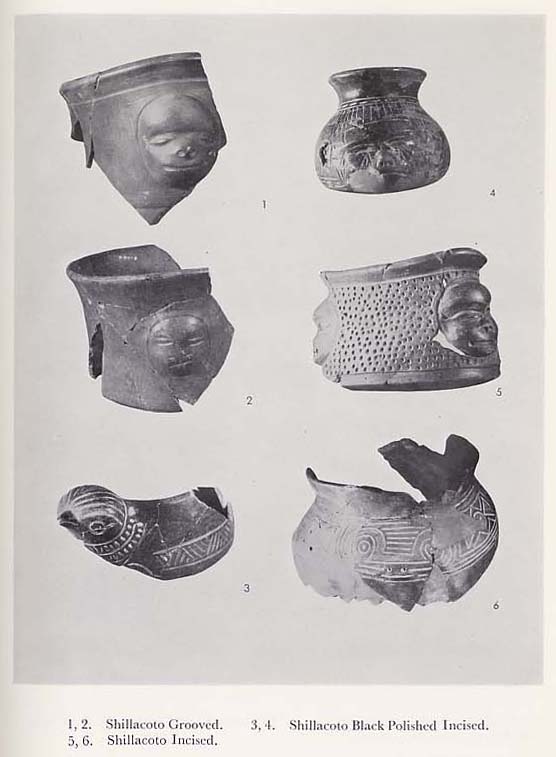
PLATE 31 |

PLATE 34 |
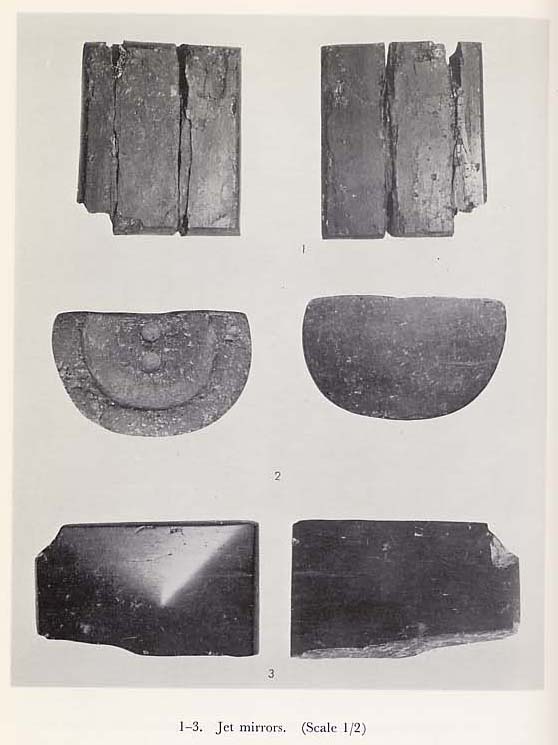
PLATE 42 |
Bottom stones of 5 or 6 cm. thick were laid underneath the human bones. The bottom stones showed traces of having been coated on the surface with a pale gray clay. A niche opening 50 cm. × 30 cm. in size was found on the south-wall of this tomb structure. However, the niche was plugged with flat stones from the inside. A great quantity of small round pebbles was discovered in the lower layers of the tomb chamber. The majority of the pebbles were coated with either white or yellow clay; It was thought that these pebbles were of an alien type to those ones found in the upper layers of the chamber. Thus the pebbles are believed to have something to do with the actual burial of the tomb, bearing special meanings.
The foundation stones of this structure were placed on a red-brown clay floor that was paved on the lower floor of the construction of the Mito Period. It was also recognized that at the area centering around the construction, about 30 cm. to 40 cm. thick black floor was placed over the red-brown flooring.
The survey conducted in 1969 also revealed two similar kinds of constructions situated on the upper floor of the Mito Period construction on the northern side. One construction (S-R14) was built inside the temple on the east side, as if the construction's west wall was pasted directly to S-W30. The other structure (S-R13) was found built on the upper floor of the temple's west side, and also appeared as if it was completely pasted on to S-W30. Since the excavation of the interior of these constructions was not conducted on this occasion, it is not yet known whether the constructions contain tombs.
Constructions of Mito Period

Fig. 9 |
S-R7 (PL. 13-a): This construction was also discovered in the deepest level of the Kotosh Site. The construction corresponded to a temple of the pre-ceramic period. Even at Shillacoto, a construction was also discovered from under the strata of the Wairajirca Period. Although the construction belongs to the oldest period, the building maintains the highest level in architecture, and when compared with constructions of other periods, it is built more intricately and is larger in scale.
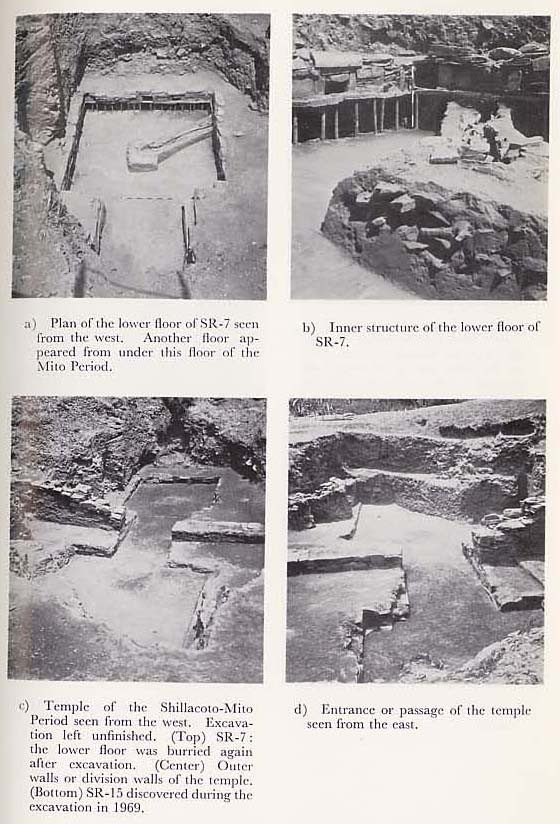
PLATE 13 |
The style of Shillacoto Temple is basically almost identical with the temples discovered at Kotosh. In other words, the plan of the structure is nearly square, with the floors divided into two parts ; an upper floor and a lower floor. In the center part of the lower floor, a hearth is placed with a smoke funnel installed underneath the floor.
Scale: The Shillacoto Temple is also large in scale, and since the structure was buried quite deep, it was impossible to excavate completely the total structure during the expeditions.
Presently, the completely unearthed parts of the construction are the lower floor, entrance-way, passageway, the west side of the encircling wall, and a portion of the upper floor connected to the wall. The walls connecting the lower floor with the upper floor are designated as S-W7, 8, 9, 10, and 26 ; the passageways as S-W27, and 28, and the encircling walls as S-W29 and 30, respectively.
The wings of S-W29, and S-W30, or of the west wall, appear to be suddenly cut off, and the condition of the undiscovered south and north wall parts that are thought to have been connected with west wall wings are not yet known. Furthermore, the precise relationship between the lower floor and the upper floor which were also discovered in the west-side, is not yet known.
The following are the findings, unfortunately limited, of the size of the Shillacoto Temple : The length of the encircling walls: Both S-W29 and 30 : about 5.8m. Thickness: 1.2m. The width of the entrance-way : about 3 m. The length of the passageways S-W27 and 28 that connect the upper floors of the east and west structures: about 6 m. However, if the encircling wall was merely a partition wall dividing the east and west sides, the length of the east side passageway (this could also become a standard to estimate the width of the upper floor of the east side) was about 2.8 m., and the length of the west passageway was 2m.Thus the west passageway was shorter than its eastern counterpart.
Since the lower floor part of the east temple was excavated for the most part, the exact measurements of the floor became available. The measurements are : total floor space 6 m. × 6 m. ; the height of the temple : about 2.5 m. above the upper floor and 3 m. above the lower floor.
From these figures, granted that the east temple would be a unit, and based on the presumption that the east temple was on a square plan like that of the Kotosh temples, the size of the original east temple can roughly be estimated as follows :
The total floor space of the structure, including the encircling walls : about 15m. × 15m. The total floor space of the interior : about 12m. × 12m. (The height from the upper floor : 2.5 m.)
Walls: The wall was damaged to a great extent, but the damage made possible easier access to the interior of the wall for close inspection of the construction of the wall. With regard to S-W30, the wall was about 1.2 m. thick, made of piled up flat stones. The size of the wall stones averaged between 80 cm. and 100 cm. in length, 40 cm. and 50 cm. in width, and 20 cm. and 30 cm. in thickness.
The planes of the wall stones were cut perpendicularly by excellent stone processing technique, showing acute angles when viewed at cross sections. The skillful dressed stones were placed horizontally lengthwise and breadthwise, side by side, depending on the width of the wall. The wall stones were neatly aligned vertically and horizontally, showing beautiful checkered and T-shape patterns that make up the sturdy and strong wall structure. Small ashlars filled the stone gaps in the wall and fine gray-brown clay material was used to cement the gaps of the wall stones. Furthermore, the encircling walls are believed to have been originally finished in fine grained yellow-brown clay, judging from the fact that, some sections on the lower level of S-W30 still show such evidence.
As mentioned previously, the walls that connect the lower floor with the upper floor were finished with a somewhat ornamental effect and were thus elaborately constructed. The walls of the upper floor at the high section were made of sturdy, thick, flat stones measuring about 15 cm. to 20 cm. in thickness and about 60 cm. to 90 cm. in length. Also the walls of the lower floor in a lower section were made of neatly and beautifully cut, rather thinner flat stones, measuring about 10 cm. in thickness and about 1 m. to 1.4 m. in length, which were placed horizontally. In the walls between the two floors, square ashlars measuring between 15 cm. and 20 cm. were placed lengthwise at certain intervals. The wall section appears as if a series of small niches had been placed in a line to present an ornamental effect. The niche-like wall was most typical at S-W10, or the wall situated immediately in front of the entranceway. Since the openings of the niche were all filled with stones, it is uncertain whether this wall part was originally constructed to include small niches.
However, when the small ashlars filling a niche on the center wall of S-W10 were removed for the sake of experiment, a neatly finished end-wall appeared. From all these, the walls can be judged to have been originally constructed to include niches; perhaps the ashlars that filled the opening part of the niches were inserted to prevent the caving in of the walls or just to show that some kind of repair work was being conducted.
Floors: There are two floors in the temple. We could get a clear picture of the lower floor from our latest survey. However, the upper floor could not be fully explained, although we could tell what it was like around the part that was in contact with the inner walls of S-W29 and S-W30 on the east. As previously mentioned in the excavation section of this report, the lower floor is about 50 cm. thick and made of very firm chocolate coloured clay containing rubble and breccia; and it appears that the floor was once coated with the same kind of yellow-brown clay of fine grains used for plastering the inner wall. The uppermost face of the lower floor is on the same level as the top face of the hearth. During our excavation activities, when we pulled off the layer or sheet of red-brown clay stuck directly over the floor face, the yellow-brown coating was found attached to part of the clay sheet. Consequently, we concluded that the floor had been finished with clay coating.
There was a thick layer of breccia and boulders piled up directly over the upper floor, and the floor itself was badly damaged. It too is a very hard brown floor containing rock fragments. The yellow-brown clay seems to have been coated over the upper floor face also. Such traces were recognized at some points along the inner wall. However, the rock fragments of the upper layer had sunk into the upper floor; we found fragments of ceramic ware stuck into the ruined surface of the floor.
Hearths: The hearth was installed around the center of the lower floor of the temple. Measuring 50 cm. across and 35 cm. deep, the inner face of the hearth was cemented with clay, and there was a chimney on the western side. The chimney is about 3.25 m. long and its cross section is of a U shape. The width of the inner side is about 15 cm. The average depth is 10 cm. and the deepest spot, the part contacting the hearth, is 25 cm. The chimney wall is built with small ashlars and the top of the chimney is covered with a stone lid. The stones were joined with clay. The chimney extended to the west; it was presumed to pass under S-W9 on its way out.
Tombs of the Higueras Period
What characterizes the Higueras Culture at Shillacoto is the existence of a large number of tombs. The tomb of this period was generally found within a cist enclosure of thin micaschist slabs and covered with a stone lid. Those tombs were constructed cither under the floor of a structure or within a wall, and their average dimension being 60 cm. ×70 cm. × 80 cm. Since there was no skeleton preserved in a perfect form, we are not in a burial position to make any definite statements. We judged from the size of the interior structure of those tombs that it was customary to bury the dead in a crouching posture.
In the case of Shillacoto, the funeral objects accompanying the dead are simple, while the stone cists are of sophisticated construction. There were some examples of a small number of articles such as ceramic vessels, clay figures buried in dedication to the dead, but, in most cases, we found no such objects in the tombs. How ever, the absence of those objects can also be explained as theft by violators. Only a small portion of skeletons had remained in the tombs; the greater portion was either pulverized or scattered into bones, thus making it impossible for us to estimate their sex and age.
The Higueras Period tombs were mainly discovered over the area of SHE as well as SHF-3—SHF-5, totalling 13 in number, out of which 7 were complete with stone cist and other accessories. The rest were found either with only part of the stone enclosure, without any enclosure but a hole cemented with clay, or without anything but a skull. In any case, they all were recognized as tombs because there were some skeleton fragments along with some artifacts. Three of them will be introduced here as representative. Refer to Table 1 for the detailed information such as location, type, scale, dedicated articles.
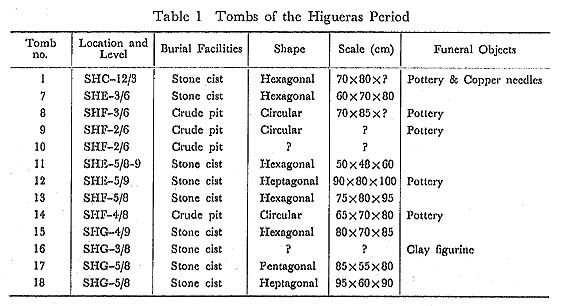
Tomb No. 7 (PL. 16): Constructed within S-W37 in the 6 layer in E-3. Approximately 60 cm.× 70 cm.× 80 cm. The stone lid covering the tomb is com-bined with part of S-W37. The hexagonal interior is walled with six micaschist slabs measuring 50 cm. high, 40 cm. wide and 2.5 cm. thick. Some human bonesv were found in the bottom stone, and there were no funeral objects inside.
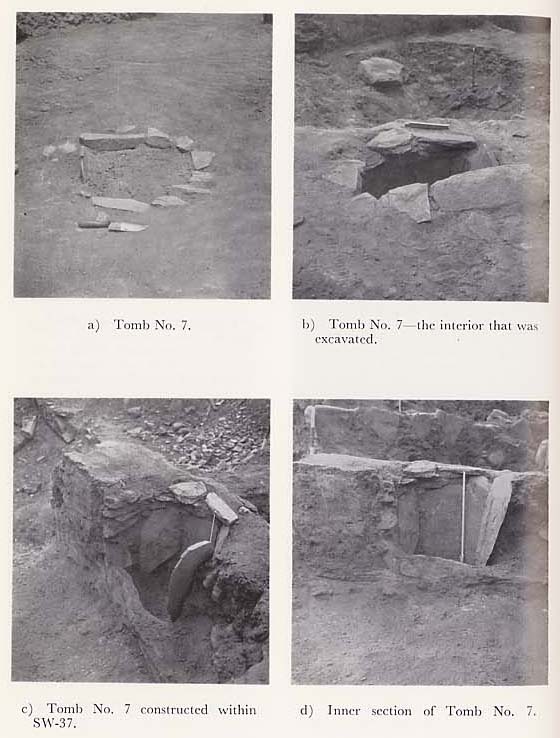
PLATE 16 |
Tomb No. 11 (PL. 17-a, b): Constructed under the floor of a Higueras Period structure in SHE-4. The tomb base is located within the southern end of S-W44 and S--W45, which are the walls of a Kotosh Period structure. Part of the wall had been destroyed to construct this tomb. Several flat natural stones placed one on top of the other were used as a lid. The stone cist there is rather small; 50 cm. × 48 cm.× 60 cm. Four fine dressed micaschist slabs were used to wall up the square interior. We found some human bones mixed with brown earth filling the interior, but could not find out any articles dedicated to the dead.
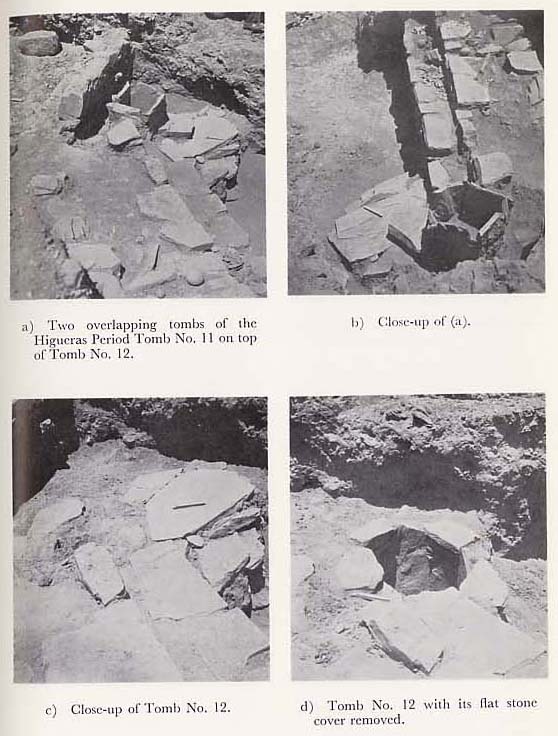
PLATE 17 |
Tomb. No. 12 (PL. 17-c, d. Fig. 11-5): Constructed right beneath the above mentioned Tomb No. 11, and the bottom stone of Tomb No. 11 was located on part of the lid stone of Tomb No. 12. Tomb No. 12 is a slightly larger tomb, measuring 90 cm. × 80 cm. × 1 m. This was also walled with slabs of micaschist and small ashlars were used to border the pentagonal upper face. A flat stone measuring 1.2 m. × 80 cm. was placed across as a lid, and several flat stones of 40 cm. × 30 cm. were placed one on top of the other on both sides of the stone lid. The gaps between stones were filled with clay. There was only a small quantity of human bone fragments found in the tomb ; and the rest of the bones were found mingled with earth in a pulverized state. The tomb contained a red Higueras Period jar with handles dedicated to the dead (PL. 18-a).

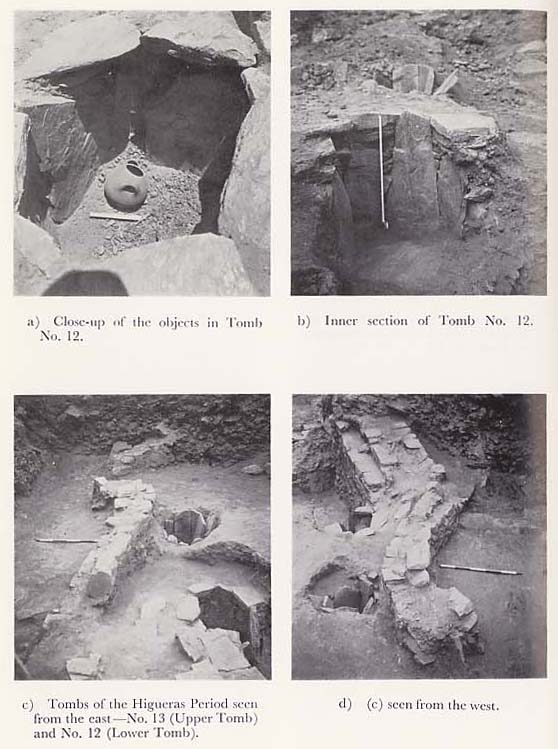
PLATE 18 |
Tombs of the Kotosh Period
Tomb No. 4 (PLs. 4-c, 5 and 6, Fig. 12): Stratigraphically speaking, this tomb in C-3 belongs to the layer beneath the floor of a Kotosh Period structure. Various articles discovered inside the tomb indicate that the tomb belongs to the Kotosh Period. It consisted of'S-W17, S-W18, and S-W19, and measures 1.8 m. × 1.4m. × 1.5m. We have already described the upper section and the layers of soil piled up inside this tomb in the excavation section of this report. There was no trace of this tomb having been covered with a stone lid. This tomb was presumed to have been connected and covered with the floor of the Kotosh Period structure on the upper section on the northern side. That particular spot was totally ruined by fallen wall stones and rock fragments having fallen into the tomb ; consequently, it was impossible for us to discover the construction of the upper part of the tomb.

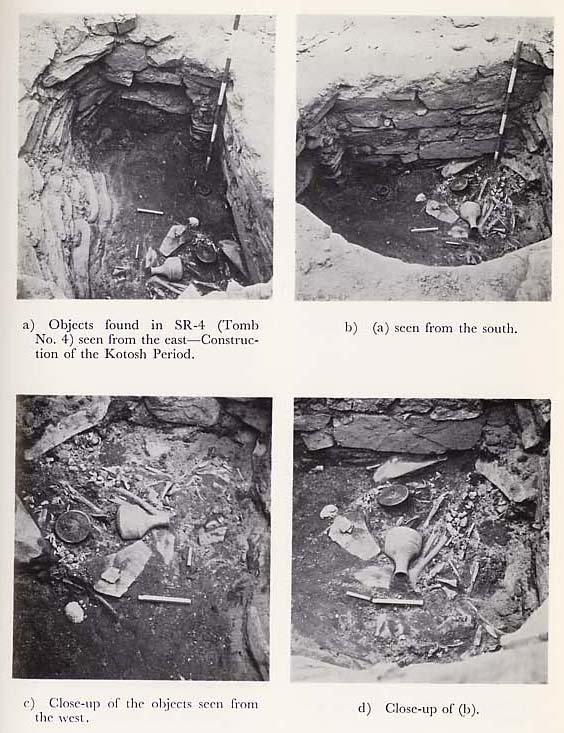
PLATE 5 |
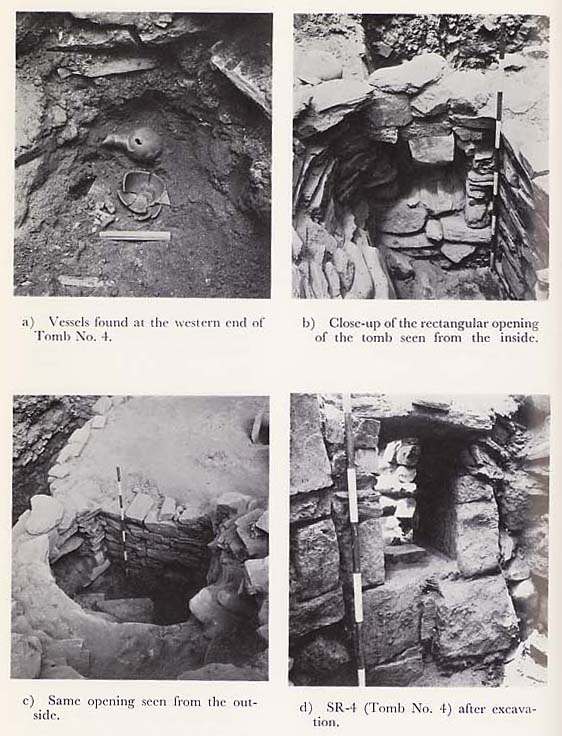
PLATE 6 |
The interior is semi-circular. The northern side partly utilizes a wall of the structure of the Wairajirca Period. The walls of S-W17, S-W18 and S-W20 of the Kotosh Period were joined to the wall of the Wairajirca Period to form the inner sepulchral wall. S-W17 was constructed with thin ashlars mixed with natural stones. To form the bend or the curved section, stones were slightly shifted in a corbelling combination, while S-W20 on the western side was built with fine rectangular dressed stones. This spot could be either a sepulchral entrance or some sort of a window through which those artifacts to accompany the dead were to be placed. In either case, there was a window-like rectangular opening measuring 60 cm.× 50 cm.
We found a body in the western part of the chamber. However, the skeleton was not in a perfect state and we could discover neither the posture nor the direction of the body at the time of burial. The artifacts buried together with the dead are 6 pieces of earthenware in complete form (PLs. 27 and 28-1, Fig. 12); 1 restorable piece of earthenware (PL. 28-2) ; 5 bone objects (PLs. 44 and 45-2—15) both perfect and restorable; 2 jet mirrors (PLs. 42-1 and 43-5); 4 chipped stone projectile points (PLs. 41-1—4 and 58-1—4); 1 stone figurine (PLs. 38-10 and 60-6); 1 stone vessel (PLs, 41-12 and 60-9) ; and 2 shell objects (PL. 46- 1,2).

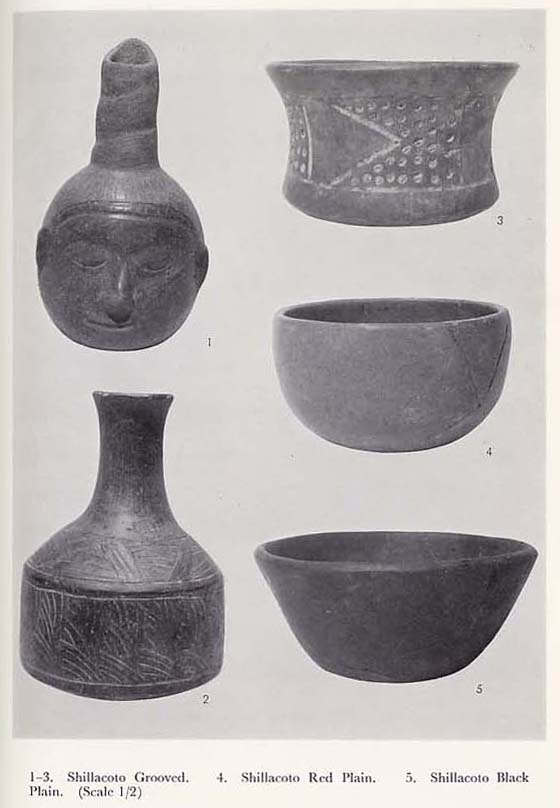
PLATE 27 |
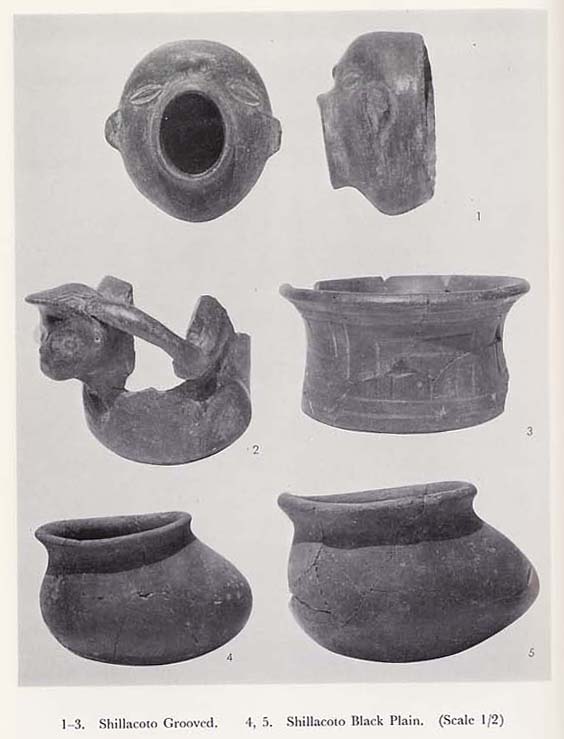
PLATE 28 |
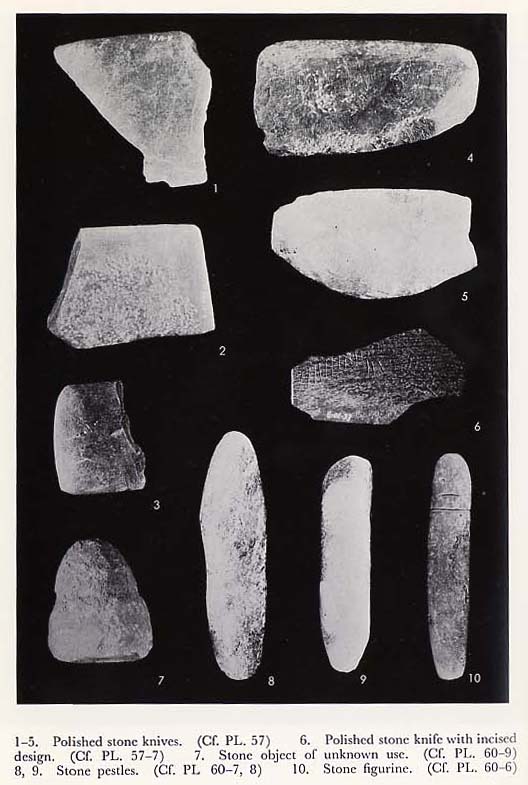
PLATE 38 |

PLATE 40 |

PLATE 41 |
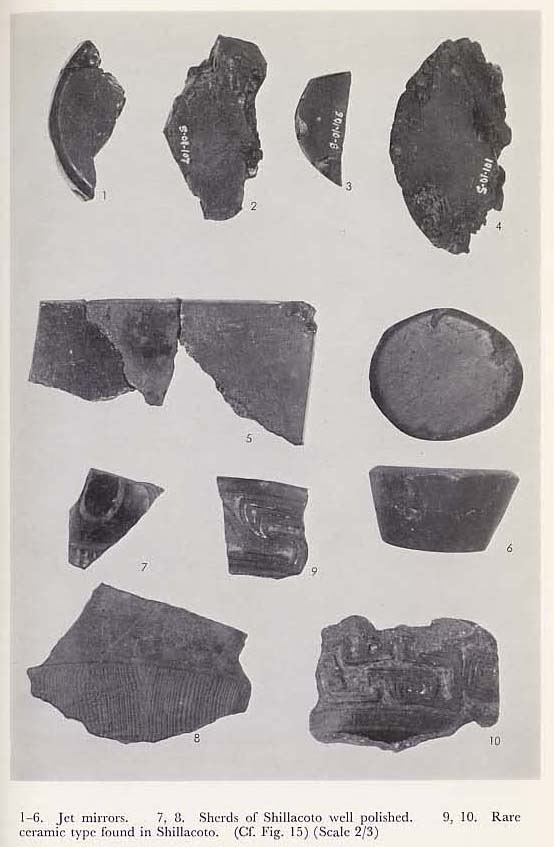
PLATE 43 |
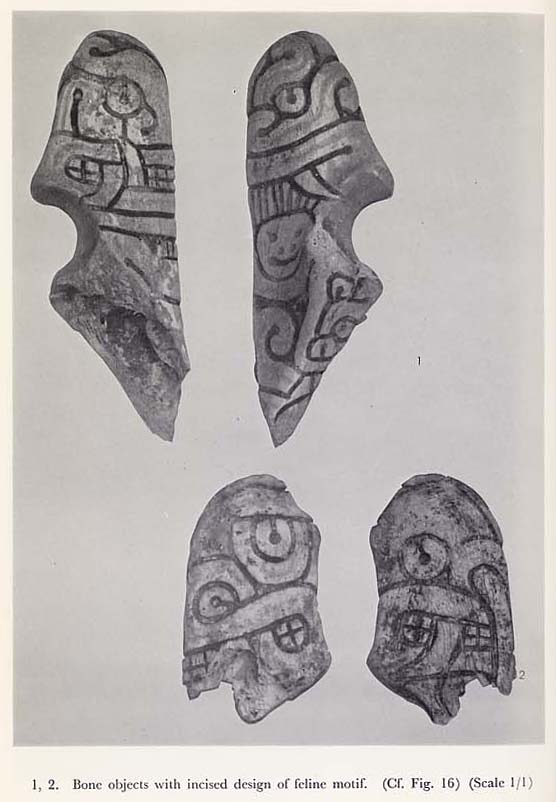
PLATE 44 |
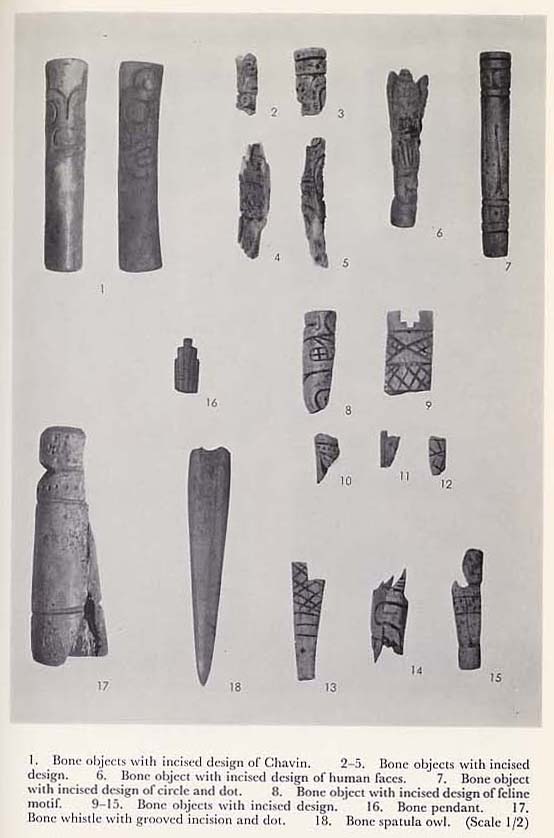
PLATE 45 |

PLATE 46 |
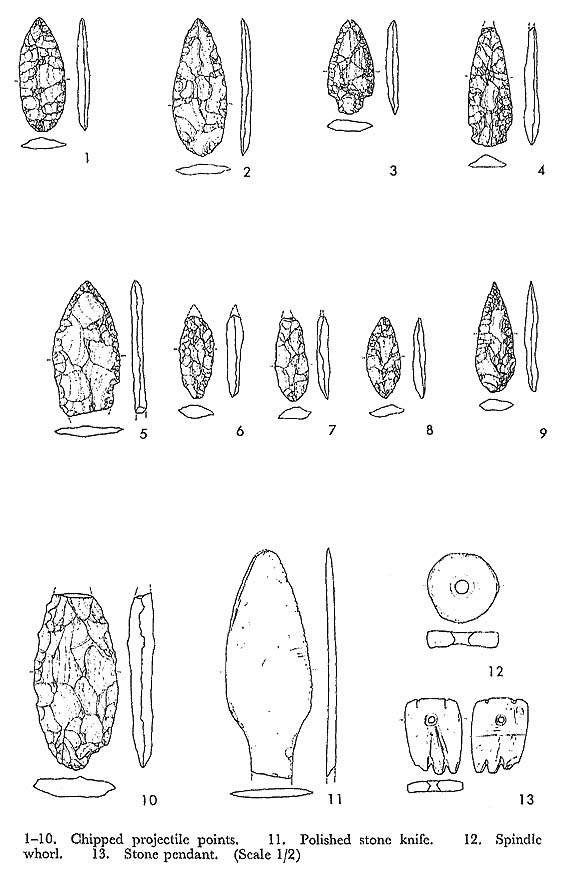
PLATE 58 |
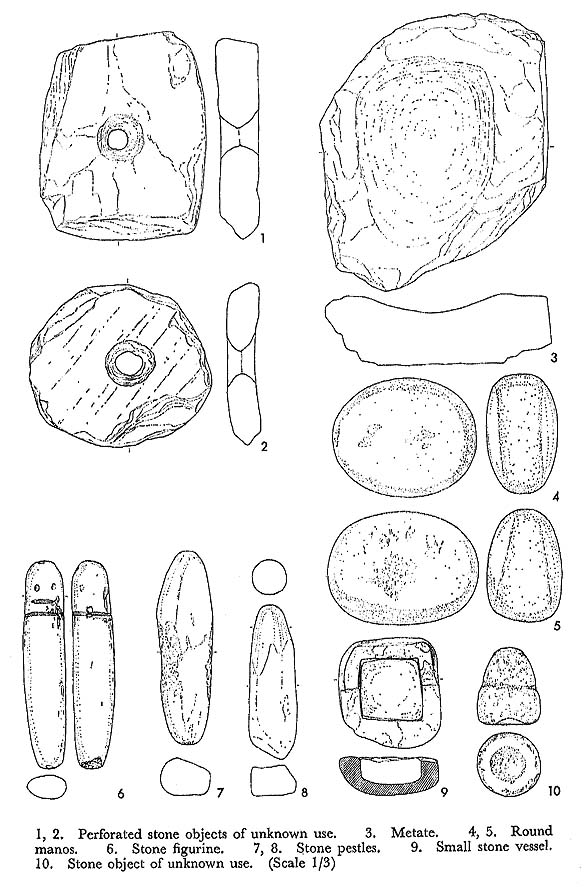
PLATE 60 |
|